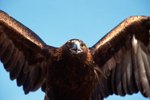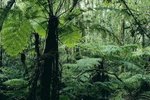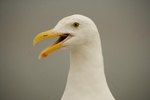
Of the 44 species of flying squirrel, two are indigenous to California: the northern flying squirrel and the San Bernardino flying squirrel. The squirrels are not capable of true flight; they glide from treetop to treetop, supported in the air by a thin membrane of skin between the squirrels' wrists and ankles.
Northern Flying Squirrel
Characterized by light brown fur on the upper body and gray patches on the flanks, the northern flying squirrel (Glaucomys sabrinus) sports large eyes and a flat, brushlike tail. This tail enables the flying squirrel to stabilize himself during longer glides. The northern flying squirrel can reach a foot in length from nose to tail-tip and weighs 2.6 to 4.4 ounces as an adult. The northern flying squirrel is more common than the Southern California species and can be readily spotted in the uppermost United States and into Canada.
Northern Flying Squirrel Diet and Habitat

Northern flying squirrels are both nocturnal and arboreal; they are awake during the night and live primarily in trees. Coniferous forests are the woodland habitats of choice for northern flying squirrels. They nest in empty hollows of dead trees and abandoned woodpecker burrows. Northern flying squirrels are omnivorous; they feast on fungi such as mushrooms and lichen, nuts and buds of trees, insects and bird eggs. Northern flying squirrels also cache lichens and dry seeds in their nests, storing them for future meals.
San Bernardino Flying Squirrel
Also known as the southern California flying squirrel -- and not to be confused with the southern flying squirrel -- the San Bernardino flying squirrel (Glaucomys sabrinus californicus) is the rare and smaller cousin of its northern relative. Originally thought to be a subspecies of the northern flying squirrel, the gray-brown San Bernardino flying squirrel has been shown through genetic testing to differ genetically; the resulting conclusion is that the bird's population numbers are much lower than initially suspected. Habitat loss due to climate change renders this particular species critically endangered.
San Bernardino Flying Squirrel Diet and Habitat

Once spotted in several mountainous ranges in southern California, the San Bernardino flying squirrel lives in only one steadily decreasing section of the San Bernardino mountains. The squirrel nests in high-elevation mixed-coniferous forests, preferring Jeffrey pines, white firs and black oaks. The primary source of food for the San Bernardino flying squirrel is the truffle, which it hunts at night on the forest floor, using keen olfactory senses. Drought has shrunk the forestation the flying squirrel inhabits, as well as drastically altered the cool, wet climate necessary for truffle and fungus growth.
References
- Northern State University: Northern Flying Squirrel
- Alaska Department of Fish and Game: Northern Flying Squirrel
- US Fish and Wildlife Service: Service Will Review Status of the San Bernadino Flying Squirrel to Determine if Endangered Species Act Protection Is Needed
- California Department of Fish and Wildlife; San Bernardino Flying Squirrel; Philip V. Brylski
- Biological Diversity: Natural History of the San Bernardino Flying Squirrel
Resources
Photo Credits
-
Jupiterimages/Photos.com/Getty Images




